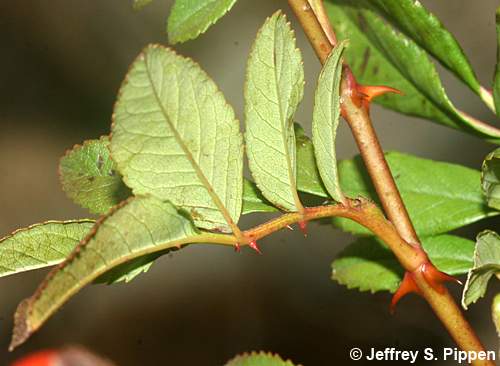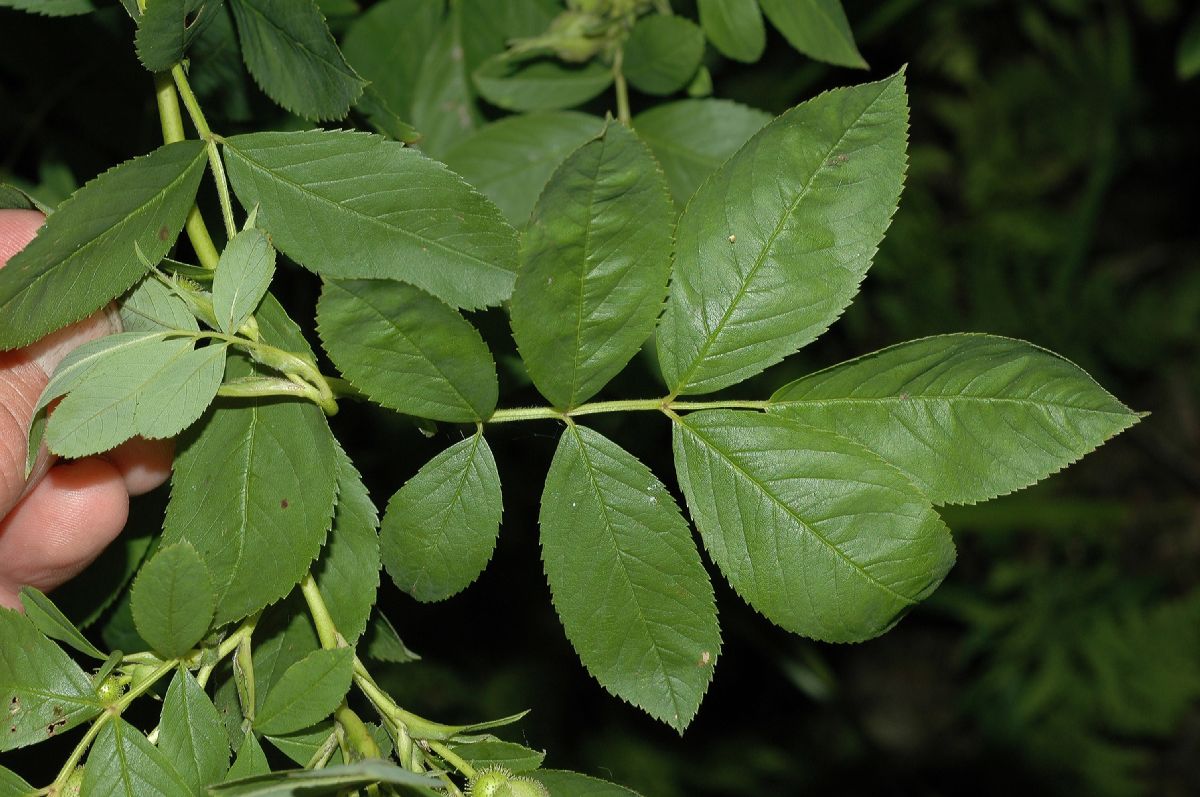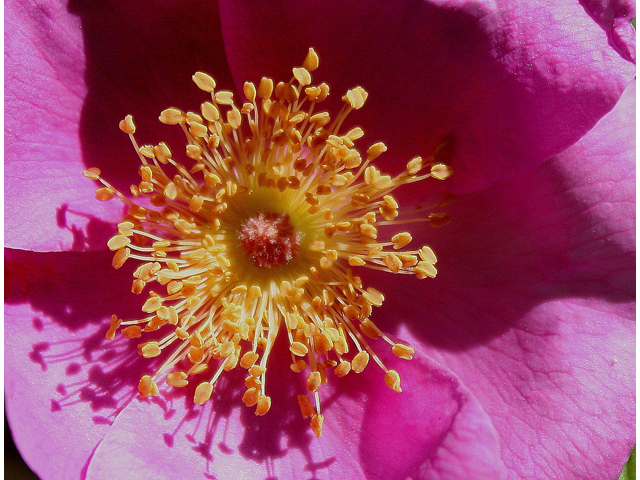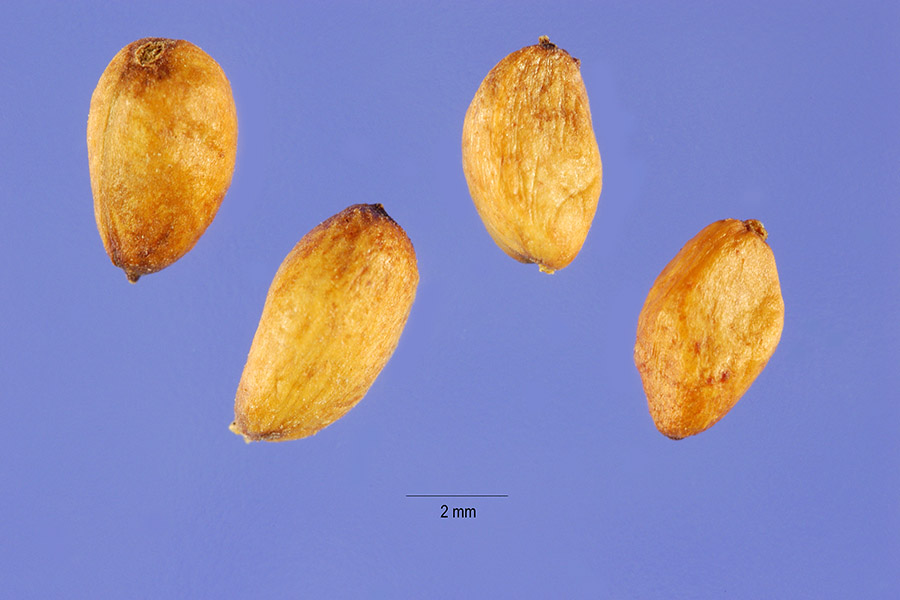 Download PDF>
Download PDF>
Name: Rosa palustris Marshall
Family: Rosaceae (the Rose family)
Common Names: Swamp rose, marsh rose (1,11).
Etymology: Rosa is the Latin word for ‘rose’, and palustris means ‘of marshes’ (8,9), indicating the species preference for wet habitats.
Botanical synonyms (4): 
Rosa floridana Rydb.
Rosa lancifolia Small
Quick Notable Features (1,6,9):
¬ Hispid-glandular pink flowers
¬ Infrastipular prickles are hooked & broad-based
¬ Arching or erect armed stems with alternate leaves & 5-9 leaflets with finely serrate margins
¬ Stipules are mostly adnate, revolute, with divergent apices, with margins entire
Plant Height: R. palustris is capable of climbing 2-3 meters high (C.V.S., pers. obs.).
Subspecies/varieties recognized (3):
R. palustris var. aculeata (Schuette) Erlanson
R. palustris var. dasistema (Raf.) E.J. Palmer & Steyerm.
R. palustris var. inermis (Regel) Erlanson
Most Likely Confused with: Rosa multiflora, R. canina, R. carolina, R. virginiana, R. setigera, Rubus ssp. especially Rubus odoratus, and Hibiscus moscheutos (rose mallow).
Habitat Preference: The swamp rose prefers moist to wet habitats: wetlands, riparian zones, swales, and ponds edges. It thrives in full or partial sun (1,4). The habitat specificity is very helpful when identifying this species.
Geographic Distribution in Michigan: R. palustris is common throughout the state, found in 68 of 83 counties. The counties with no record for the species are Saginaw, Isabella, Osceola, Gladwin, Arenac, Missaukee, Iosco, Crawford, Oscoda, Alcona, Montmorency, Alpena, Dickinson, Iron, and Gogebic (1).
Known Elevational Distribution: In Reynolds, MO, the swamp rose is found up to 317m above sea level (3).

Complete Geographic Distribution: Native to North America. In the U.S., R. palustris is found in every state east of Iowa; in Canada, nearly all states east of Ontario (4,11).
Vegetative Plant Description: Rosa palustris is a perennial woody shrub with arching to erect terete stems (up to 1.2cm in diameter) that are green to reddish, hairless, and armed with stout prickles (0.2-1cm long and often paired). The prickles up to 1cm broad at the base, are usually curved, and most commonly found below the nodes and scattered between nodes. The stipules are adnate to the petiole most of their length with divergent apices 0.2-0.6cm long, and often glandular; the adnate portion is linear, 1-3cm long, and < 0.3cm broad, the entire margins revolute. The leaves are alternate and odd-pinnately compound (5-9 leaflets), glabrous above and minutely pubescent below, with a few smaller prickles on the petiole and midrib. Each leaflet is ovate to elliptic with an acute apex, 2-6.3cm long and 0.9-3cm broad, the margins are finely serrate with ca. 20 teeth on each side (1,6,9,10,12,13,14,15).
Climbing Mechanism: R. palustris climbs with the aid of its hooked prickles and arches over adjacent vegetation (C.V.S., pers. obs., 6).
Flower Description: The perfect and conspicuous flowers are solitary or borne in corymbs of up to 9 in the axils of the terminal leaves, on glandular-hispid pedicels. Each flower is actinomorphic, fragrant, 3.8-7.6cm across, and subtended by leaf-like bracts. The 5 sepals (2-3cm long) are

green, glandular, and lanceolate. The 5 pink petals (2-3cm long) are oval to broadly obovate, and emarginate. The hypanthium bears at least 86 glandular hairs, and a ring of many stamens around the many yellow, pink, or orange pistils, which are shorter than the stamens, bearing pubescent styles (1,6,9,12,13,14,15).
Flowering Time: Swamp rose blooms May-August, depending on latitude (5,9).
Pollinator: The showy, fragrant flowers attract bees, flies, and beetles, although the most efficient pollinators are bumblebees and long-tongued bees. Insects visit the flowers for the pollen, since no nectar is available (1,6).
Fruit Type and Description: The fruit is a round aggregate of many achenes, known as a “rose hip”. They are fleshy, glandular-hispid to smooth (depending on age), 0.8-1.5cm across, red at maturity. The sepals spread as the fruit develops, but eventually fall off (6,9,10,15).

Seed Description: Individual achenes containing a single seed are tan to brownish, elliptic to ovate, pubescent, 2.5-3.5mm long and 1.5-2mm wide (9,15).
Dispersal Syndrome: The conspicuous rose hips attract birds that consume and disperse the seeds. R. palustris also successfully reproduces vegetatively by rhizomes (6,10).
Distinguished by: Rosa multiflora can be easily distinguished by its deeply pinnatifid stipules, and its densely grouped white flowers with glabrous pedicels and hypanthia; R. palustris stipules are entire, its flowers are pink and not densely grouped, with glandular-hispid pedicels and hypanthia. The leaves of R. canina are glabrous on both surfaces, as are the pedicel and hypanthium of the white or pink flowers. R. palustris leaves are pubescent below. R. carolina is found in drier habitats, bears straight infrastipular prickles, the leaflets have coarsely serrate margins, and the hypanthium bears less than 86 glands. R. palustris grows in wet habitats, bears curved infrastipular prickles, the leaflets have finely serrate margins (more teeth), and the hypanthium bears more than 86 glands. R. virginiana has glabrous leaflets with coarsely serrate margins, hypanthia with less than 86 glands, and rarely bears prickles between the nodes. R. palustris bears a few prickles between the nodes. R. setigera leaves usually have only 3 leaflets that are coarsely serrate, the pistils are united in a column at least as long as the stamens and glabrous. R. palustris leaves have at least 5 leaflets, the pistils are not united in a column longer than the stamens, and the styles are pubescent. Rubus ssp. leaves, when bearing more than 3 leaflets, are palmately compound, while R. palustris leaves are pinnately compound. Additionally, most Rubus flowers are white and the fruits are  aggregates of drupelets, commonly known as raspberries, blackberries, and dewberries. Rosa palustris fruits are rose hips. Rubus odoratus has pink flowers that may be confused with Rosa, but the species is distinguished by the simple, deep palmately lobed leaves, unarmed stems, and peduncles bearing 3-7 flowers that produce raspberries. Hibiscus moscheutos is herbaceous with simple leaves and conspicuous pink flowers (in Michigan), however the petals are larger (4.5-9cm long), the stamens are united into a column, the styles are fused and topped by 5 capitate stigmas, and the fruit is a glabrous capsule (1,9,12,15).
aggregates of drupelets, commonly known as raspberries, blackberries, and dewberries. Rosa palustris fruits are rose hips. Rubus odoratus has pink flowers that may be confused with Rosa, but the species is distinguished by the simple, deep palmately lobed leaves, unarmed stems, and peduncles bearing 3-7 flowers that produce raspberries. Hibiscus moscheutos is herbaceous with simple leaves and conspicuous pink flowers (in Michigan), however the petals are larger (4.5-9cm long), the stamens are united into a column, the styles are fused and topped by 5 capitate stigmas, and the fruit is a glabrous capsule (1,9,12,15).

Other members of the family in Michigan (number species): Rubus (49), Crataegus (42), Rosa (17), Prunus (16), Potentilla (11), Geum (9), Amelanchier (6), Spiraea (6), Agrimony (5), Malus (4), Sanguisorba (3), Sorbus (3), Physocarpus (2), Fragaria (2), Gillenia (2), Photinia (2), Argentina (1), Aruncus (1), Chamaerhodos (1), Comarum (1), Dalibarda (1), Dasiphorda (1), Duchesnea (1), Filipendula (1), Pyrus (1), Sibbaldiopsis (1), Sorbaria (1), Waldsteinia (1) [source 1].
Ethnobotanical Uses: Due to its beautiful and fragrant flowers, R. palustris is often cultivated as an ornamental species. An infusion prepared from the bark and roots is used by the Cherokees as a dewormer and to treat diarrhea and dysentery (10).
 Phylogenetic Information: The genus Rosa is classified as member of the subfamily Rosoideae in the Rosaceae, which is in the order Rosales, a Eudicot clade of the angiosperms. Members of the Rosaceae are found worldwide and the genus Rosa is found in northern temperate climates (2).
Phylogenetic Information: The genus Rosa is classified as member of the subfamily Rosoideae in the Rosaceae, which is in the order Rosales, a Eudicot clade of the angiosperms. Members of the Rosaceae are found worldwide and the genus Rosa is found in northern temperate climates (2).
Interesting Quotation or Other Interesting Factoid not inserted above: The swamp rose is considered a high quality wetland indicator species. The plant serves as the host and/or as a food source for many insects and vertebrates such as caterpillars, aphids, birds, and small rodents (6). The Coefficient of Conservatism for R. palustris is 7, “… a value that ranges from 0 for non-native invasives to 10 for plants that would only be expected to be found in undisturbed, high quality plant communities” (7).
Literature and websites used:
- Michigan Flora Online. A.A. Reznicek, E.G. Voss, & B.S. Walters. February 2011. University of Michigan. Web. July 24, 2013. http://michiganflora.net/species.aspx?id=2544.
- Stevens, P.F. Angiosperm Phylogeny Website. Version 12, July 2012. http://www.mobot.org/mobot/research/apweb.
- Tropicos.org. Missouri Botanical Garden. 24 Jul 2013 <http://www.tropicos.org/Name/27801155>
- USDA, NRCS. 2013. The PLANTS Database (http://plants.usda.gov, 07/24/2013). National Plant Data Team, Greensboro, NC 27401-4901 USA.
- TWC Staff 2012. Native Plant Database. Lady Bird Johnson Wildflower Center. http://www.wildflower.org/plants/result.php?id_plant=ROPA
- Hilty, J. 2004-2013. Wetland Wildflowers of Illinois. http://www.illinoiswildflowers.info/wetland/plants/sw_rose.html
- Landis, D. & A. Fiedler 2013. Native Plants and Ecosystems Services. http://nativeplants.msu.edu/uploads/files/Swamp%20rose.pdf
- Mahoney, K. 2002-2013. Latdic. http://www.latin-dictionary.net/
- Fernald, M.L. 1950. Gray’s Manual of Botany, 8th ed. New York: American Book Co.
- Mueller, P. et al. 2000. Illinois State Museum Tree Guide. http://www.museum.state.il.us/muslink/forest/htmls/trees/R-palustris.html
- Gbif.org. Global Biodiversity Information Facility Website. Accessed: 24 July 2013.
- Joly, S. & A. Bruneau 2007. Delimiting species boundaries in Rosa sect. Cinnamomeae (Rosaceae) in eastern North America. Systematic Botany 32(4): 819-836.
- Lewis, W.H. 1958. The roses of Virginia and West Virginia. Castanea 23(3): 77-88.
- Godfrey, R.K. 1988. Trees, Shrubs, and Woody Vines of Northern Florida and Adjacent Georgia and Alabama. Athens, Georgia, USA: The University of Georgia Press.
- Radford, A.E., H.E. Ahles, & C.R. Bell. 1968. Manual of the Vascular Flora of the Carolinas. Chapel Hill, North Carolina, USA: The University of North Carolina Press.
Image Credits (all used with permission):
1. Image of entire plant courtesy of Jeff Pippen, http://www.jeffpippen.com/plants/rosa.htm
2. Image of hooked prickles courtesy of Jeff Pippen, http://www.jeffpippen.com/plants/rosa.htm
3. Image of leaf courtesy of Kevin C. Nixon, http://www.plantsystematics.org/
4. Image of flower buds courtesy of Will Cook, http://www.carolinanature.com/trees/ropa.html
5. Image of close-up flower courtesy of R.W. Smith, Lady Bird Johnson Wildflower Center http://www.wildflower.org/gallery/result.php?id_image=30833
6. Image of fruits courtesy of R.W. Smith, Lady Bird Johnson Wildflower Center http://www.wildflower.org/gallery/result.php?id_image=32275
7. Image of seeds courtesy of Steve Hurst @ USDA-NRCS PLANTS Database http://plants.usda.gov/java/largeImage?imageID=ropa_002_ahp.tif
8. Species distribution map, derived from the Michigan Flora Online.
Primary Author: Cristine V. Santanna with revisions and editing by John Bradtke and Robyn J. Burnham.
© Robyn J. Burnham
For additional information on Michigan Plant Diversity species accounts, please contact Robyn J. Burnham via email: rburnham“at”umich.edu